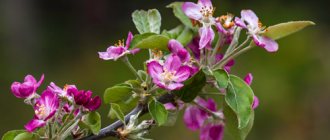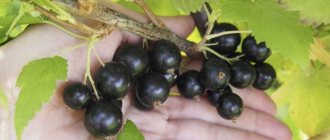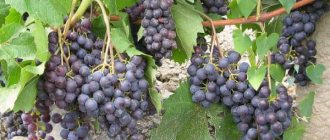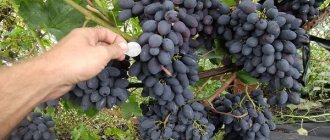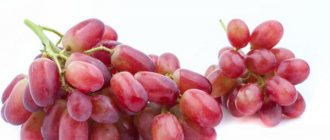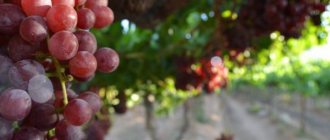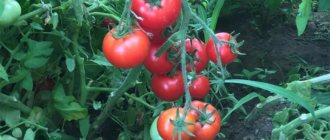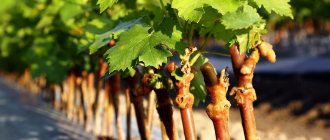Distinctive features of the variety
It is impossible not to notice apples of this variety among many others. The flesh is reddish (sometimes even raspberry) and has a pearlescent tint, and the aroma is slightly reminiscent of raspberries. The apples are juicy and soft, with a high percentage of juice content. The dark red skin is also plum-colored and strewn with white dots.
Belongs to early winter varieties. The harvested crop can be stored for up to four months. These apples are suitable for both technical and home cultivation. Their low calorie content makes them a dietary product, and regular use promotes weight loss. Due to its unusual spicy taste, this variety is used to prepare spicy dishes, and the crushed seeds are added to pepper mixtures.
Features of agricultural technology of Zhemchug Saba grapes.
The variety can be cultivated on a trunk 70-120 cm high with a feeding area of 3x1.5 m. When cultivated with a standard-free fan type of bush formation, the feeding area is 2.5 x 1.25 m. 35-40 live eyes are left on the bush, 27- 30 escapes. The pruning length of fruit vines is average. Grows well and bears fruit on dark gray loamy soils. When applying fertilizers, the power of the bush increases. The best soils for this grape variety are chernozem soils, as well as light loamy ones, well supplied with moisture and nutrients. The best rootstocks for this variety in the Odessa region are: Berlandieri x Riparia Teleki 5 C and CO4.
Tree care
Caring for a young tree must include:
- regular watering, especially in the first years after planting;
- fertilizing with organic and mineral fertilizers;
- mulching the soil around the trunk - manure is usually used, and the top is covered with grass or straw to retain water;
- regular pruning, removal of unnecessary branches growing inside the crown;
The Pink Pearl apple tree is well pollinated by other varieties, so it is best to plant several different trees in one garden, this will significantly increase the amount of harvest.
Pink Pearl apples ripen in September, but if you leave them on the tree for as long as possible (1-2 months), they will become even more juicy and will be preserved well throughout the winter.
Result:
This variety of apples is undoubtedly worth planting in your summer cottage. Its seedlings are well transported and take root easily, without requiring painstaking care. And unusual fruits have beneficial properties and good taste.
is an extremely rare jewel because by definition it must be formed without human intervention. And pink pearls belong to the category of the rarest. Knowing the history of pink pearls, including their origins and the reason for their unusual coloring, can help you better appreciate them.
Origin of Pink Pearls Almost all pearls sold today are cultured, either freshwater or saltwater. Akoya pearls and South Sea pearls, both of which are marine varieties, can be naturally pink in color. But freshwater pearls have to be dyed after harvesting to make them pink. Caribbean pink pearls are especially beautiful. It is produced by the Strombus clam. To find one high-quality pearl, it was necessary to open a hundred thousand shells, so the Strombus soon became an endangered species. These pink pearls have a unique quality: when the pearl is exposed to light, it burns with a “flame.”
History of Pearl Diggers For thousands of years, pearl hunters have dived into the depths of the sea in the vague hope of finding natural pearls in the Red Sea, Indian Ocean, Persian Gulf and Gulf of Manara. Most of the natural pearls sold today were harvested a long time ago and are now worth a lot of money. The divers collected as many shellfish as they could, and only then they were carefully examined for the presence of pearls. This work was usually carried out by slaves or people of very low social status, because divers often drowned or died from other dangers that threatened those who risked diving too deep into the ocean waters by simply holding their breath. Slaves were sometimes able to buy their freedom if they found a particularly large pearl.
History of pearl cultivation Artificial cultivation of pearls began about 100 years ago. The mollusk forms a pearl by covering a foreign body that accidentally gets into the shell with many layers of nacre substance. Therefore, farmers learned to insert the irritant into the folds of the mollusk's mantle. Pearl cultivation takes 9-16 months for Akoya pearls, and 2-7 years for freshwater pearls. The popularity of cultured pearls grew significantly after Coco Chanel began using them in her designs in the 1930s.
Caribbean pink pearls Strombus is a very sensitive mollusk, so all attempts to grow Caribbean pink pearls artificially have ended in failure. Every year, 2-3 thousand pink pearls are mined off the coast of Florida, the Bahamas, the Yucatan Peninsula and the Antilles. Of these, only 15-20% are suitable for. These pearls are heavier and harder than any other. The fact that the Strombus is in danger of extinction has led to strict controls on pearl harvesting, so Caribbean pink pearls are likely to remain a very rare gem.
Other Types of Pink Pearls Akoya and South Sea pearls come in many colors, including pink. Although pink pearls of these varieties will not have such a rich hue as Caribbean pink. Freshwater pearls are easy to dye, so they are often produced in response to consumer demand. Freshwater pearls are rarely round because the implant is made from the mantle tissue of the “donor” rather than a round piece of shell, as is the case in saltwater pearls. But for the same reason, freshwater pearls are much more durable.
Especially for a fashion magazine about beauty, health, relationships and comfort in the home
It is not easy to grow such a southern crop as grapes in the climatic conditions of the middle zone. Therefore, varieties that have good frost resistance, are resistant to diseases and ripen well in our latitudes are of particular value.
One of these crops is the Pink Pearl fruit grape. The Pink Pearl variety was the result of selection carried out by employees of the Research Institute of the Academy of Agricultural Sciences, located in Michurinsk.
The prototype of the Pink Pearl variety was the early ripening variety “Saba Pearl”. Its description largely coincides with the Pink Pearl variety.
Characteristics
The yield of the variety is high - 6-8 kg of tasty, sweet berries are obtained from the bush. There are few seeds in them.
The Pink Pearl variety has increased resistance to traditional fungal diseases and pests. The frost resistance of the variety is very high (up to -30°C); it can winter on trellises.
The percentage of ripened berries of the Pink Pearl variety reaches 95%. Grapes are used for making juices, wine and fresh.
Description of the chemical composition of berries:
- the variety has high sugar accumulation - 20-25%;
- acidity is 6-9 g/l.
Transportation of the Pink Pearl variety is possible; transportation ability is not the strong point of the variety.
Botanical and technical description of the variety
Pearl vines have individual characteristics that distinguish them from other varieties. Before growing plants, you should read the detailed description of the variety.
Vine and shoots
Young shoots turn purple. The upper part of the shoots is covered with cobwebby pubescence. By the time they ripen, the shoots turn brown.
Productivity and fruits
The Zhemchug grape is considered an early table variety that produces a harvest in mid-summer. The rounded fruits are medium in size, amber in color and have thin skin. The pulp of the berries is valued for its unique taste with a predominant nutmeg aroma.
Landing
It is necessary to choose a warmer place for planting pink pearl grapes. It is better if it is the sunny side of the house. You can also plant bushes along the border of the garden plot. Good lighting will be provided here. If the planting is located next to buildings, it is necessary to avoid water flowing onto it from the roofs. On rich soils, grape roots form well at first. In the future, good drainage is necessary to prevent waterlogging and lack of air.
The Pink Pearl variety is planted in spring, when the earth has dried and warmed up.
Variety planting time:
- south – May 6-25;
- north – June 5-30.
If you plan to plant grapes in a separate plot in rows, a row spacing of 2 m and a distance of 1.5 m inside the row will be sufficient. The best results when planting are obtained by seedlings of the Pink Pearl variety, one to two years old, with developed roots.
In preparation for planting, the main roots are shortened to 15 cm. In order not to harm the root system, it is necessary to preserve the roots at the nodes of the shoots, using an inclined planting. Together with the roots, the shoot is cut off, where up to 4 mature underlying buds remain. The roots are then dipped in mash or stored in a bucket filled with water.
Deep holes up to 1 m in size are first dug. A mixture containing fertilized soil is placed at the bottom of the hole. The roots of a grape seedling are placed there and watered with water. Then the hole is completely filled with manured soil. After planting, water again, then the plant protruding from the ground is covered with fertilized soil to a height of 0.05 m above the cut of the shoot. A stake is planted near all plants. Emerging shoots are tied to it.
Then the grapes need to be watered regularly in dry weather. In order for the Pink Pearl variety to grow better, watering must be carried out in conjunction with fertilizing. It can be slurry diluted in water. To make ripening go better, the stepsons break off.
In the first year, you need to get at least two strong shoots of Pink Pearl. Then the conditions for the formation of the bush in the future will be created.
Grape pink pearl
It is not easy to grow such a southern crop as grapes in the climatic conditions of the middle zone. Therefore, varieties that have good frost resistance, are resistant to diseases and ripen well in our latitudes are of particular value.
One
One of these crops is the Pink Pearl fruit grape. The Pink Pearl variety was the result of selection carried out by employees of the Research Institute of the Academy of Agricultural Sciences, located in Michurinsk.
The prototype of the Pink Pearl variety was the early ripening variety “Saba Pearl”. Its description largely coincides with the Pink Pearl variety.
| Purpose of the variety | Universal |
| Acidity of the variety | 6 - 9 g/l |
| Sugar content of the variety | 20 — 25 % |
| Ripening time | Early (115-120 days) |
| Bunch shape | Conical |
| Bunch weight | Up to 500 g |
| Berries shape | Round |
| Berry weight | 6 g |
| Berry color | Light pink |
| Frost resistance | Up to -30°С |
| Yield per bush | 6-8 kg |
The yield of the variety is high - 6-8 kg of tasty, sweet berries are obtained from the bush. There are few seeds in them.
The Pink Pearl variety has increased resistance to traditional fungal diseases and pests. The frost resistance of the variety is very high (up to -30°C); it can winter on trellises.
The percentage of ripened berries of the Pink Pearl variety reaches 95%. Grapes are used for making juices, wine and fresh.
Description of the chemical composition of berries:
The variety has high sugar accumulation - 20-25%; Acidity is 6-9 g/l.
Transportation of the Pink Pearl variety is possible; transportation ability is not the strong point of the variety.
It is necessary to choose a warmer place for planting pink pearl grapes. It is better if it is the sunny side of the house. You can also plant bushes along the border of the garden plot. Good lighting will be provided here. If the planting is located next to buildings, it is necessary to avoid water flowing onto it from the roofs. On rich soils, grape roots form well at first. In the future, good drainage is necessary to prevent waterlogging and lack of air.
The Pink Pearl variety is planted in spring, when the earth has dried and warmed up.
Variety planting time:
South - May 6-25; North - June 5-30.
If you plan to plant grapes in a separate plot in rows, a row spacing of 2 m and a distance of 1.5 m inside the row will be sufficient. The best results when planting are obtained by seedlings of the Pink Pearl variety, one to two years old, with developed roots. In preparation for planting, the main roots are shortened to 15 cm. In order not to harm the root system, it is necessary to preserve the roots at the nodes of the shoots, using an inclined planting. Together with the roots, the shoot is cut off, where up to 4 mature underlying buds remain. The roots are then dipped in mash or stored in a bucket filled with water.
Deep holes up to 1 m in size are first dug. A mixture containing fertilized soil is placed at the bottom of the hole. The roots of a grape seedling are placed there and watered with water. Then the hole is completely filled with manured soil. After planting, water again, then the plant protruding from the ground is covered with fertilized soil to a height of 0.05 m above the cut of the shoot. A stake is planted near all plants. Emerging shoots are tied to it.
Then the grapes need to be watered regularly in dry weather. In order for the Pink Pearl variety to grow better, watering must be carried out in conjunction with fertilizing. It can be slurry diluted in water. To make ripening go better, the stepsons break off.
In the first year, you need to get at least two strong shoots of Pink Pearl. Then the conditions for the formation of the bush in the future will be created.
The Pink Pearl variety bush is formed from the first season by breeding 2 shoots. They will become his shoulders. Excess shoots are removed. For the 2nd season, 3 buds are kept on the shoots, the rest is removed. In summer, each bud produces several shoots. In the 3rd season, the 3 strongest shoots are kept on the shoulders, cut to 0.5 m, the rest is removed. This is how the sleeve of the bush is formed. In summer, up to 3 shoots are grown on the sleeves. There can be up to 12 shoots on a bush. The next season, the upper shoot is intended for fruiting. It is trimmed to 12-15 buds. The lower shoot is used for replacement - it is cut into three buds. The sleeve and shoots form the fruiting unit. Up to six fruit links remain on the bush. In the future, fruitful shoots will develop from the buds with a grape harvest. In the fourth season, the Pink Pearl variety becomes capable of bearing fruit en masse. When the bush begins to bear fruit en masse, the cover is removed. This should be done by choosing the right timing, without freezing or crushing the fruit buds. After opening, the grapes are pruned and the sleeves are tied to the trellis, followed by the fruit vines.
In places with temperatures above -16°C, the Pink Pearl variety does not need to be covered. This is required at frost temperatures of -20°C - 25°C. To cover, the grapes are removed from the trellis and pruned. Next, it is treated with copper sulfate.
It is best to cover the vines using the air-dry method, which is considered preferable. For it, roofing felt is used, on which the vine is placed, fixed with wire. A layer of dry foliage is created above. Then a frame is made to tension the film, in which it is necessary to provide ventilation holes that can be closed in case of severe frosts.
In snowy regions, the Pink Pearl grape variety is covered with snow.
Covering the vine must be done before severe frosts occur, since otherwise the vine becomes brittle. But there is no need to rush into shelter. It is useful to harden grapes. First, up to 10 days you need a temperature from 0 - +10°C. And then hardening continues with slight frosts down to -5-7°C.
Bush formation
- The Pink Pearl variety bush is formed from the first season by breeding 2 shoots. They will become his shoulders. Excess shoots are removed.
- For the 2nd season, 3 buds are kept on the shoots, the rest is removed. In summer, each bud produces several shoots.
- In the 3rd season, the 3 strongest shoots are kept on the shoulders, cut to 0.5 m, the rest is removed. This is how the sleeve of the bush is formed. In summer, up to 3 shoots are grown on the sleeves. There can be up to 12 shoots on a bush. The next season, the upper shoot is intended for fruiting. It is trimmed to 12-15 buds. The lower shoot is used for replacement - it is cut into three buds. The sleeve and shoots form the fruiting unit. Up to six fruit links remain on the bush. In the future, fruitful shoots will develop from the buds with a grape harvest.
- In the fourth season, the Pink Pearl variety becomes capable of bearing fruit en masse. When the bush begins to bear fruit en masse, the cover is removed. This should be done by choosing the right timing, without freezing or crushing the fruit buds. After opening, the grapes are pruned and the sleeves are tied to the trellis, followed by the fruit vines.
History of selection
Breeders first became acquainted with the Pearl grapes at the beginning of the 20th century. It was then that bushes were grown from an unknown seed, bearing amazing fruits that looked like pearls. They were covered with a waxy coating on top. A little later, scientists crossed Muscat Hungarian and Ottonel and obtained grapes with similar characteristics.
Thanks to this, the parent pair of Pearls was established. The variety has become widespread in Eastern European countries and Transcarpathia.
Shelter
In places with temperatures above -16°C, the Pink Pearl variety does not need to be covered. This is required at frost temperatures of -20°C – 25°C. To cover, the grapes are removed from the trellis and pruned. Next, it is treated with copper sulfate.
It is best to cover the vines using the air-dry method, which is considered preferable. For it, roofing felt is used, on which the vine is placed, fixed with wire. A layer of dry foliage is created above. Then a frame is made to tension the film, in which it is necessary to provide ventilation holes that can be closed in case of severe frosts.
In snowy regions, the Pink Pearl grape variety is covered with snow.
Covering the vine must be done before severe frosts occur, since otherwise the vine becomes brittle. But there is no need to rush into shelter. It is useful to harden grapes. First, up to 10 days you need a temperature from 0 - +10°C. And then hardening continues with slight frosts down to -5-7°C.
Grapes are a crop primarily intended for cultivation in southern latitudes. Therefore, varieties with good frost resistance are of particular interest to winegrowers in Central Russia. Today, quite a lot of such varieties have been bred, one of them is the “Pink Pearl” grape.
Pests and diseases
The description of the Pearl Sabo grape variety indicates that the variety has a low immune system, and is therefore often affected by powdery mildew, fruit rot and fusarium.
- There is no effective remedy against powdery mildew. The entire plant will have to be eradicated.
- A solution of colloidal salt (3 g per 10 liters of water) will help get rid of fruit rot.
- In the fight against fusarium, a manganese solution (5 g per 10 liters of water) will come to the rescue.
Pests include codling moth and moth. It is worth fighting the codling moth with a solution of Bordeaux mixture (4 g per 10 liters of water). A tincture of garlic or onion (300 ml of garlic or onion juice per 10 liters of water) will help destroy midges. As a preventive measure against pests and diseases, spray with copper sulfate (50 g per 10 liters of water).
Description of the variety
“Pink pearls” have early ripening periods, the growing season lasts 115-120 days. At the end of August it is already possible to harvest.
The main advantage of the variety is its high frost resistance; the vine can withstand temperatures below 30 degrees. It can overwinter on trellises without shelter where the temperature does not drop below -18 C°. “Pink pearls” tolerate drought well and are slightly affected by fungal diseases.
The berries are light pink and round in shape; one berry weighs 6 grams. Despite its not very presentable appearance, the variety has good taste: sugar content 20-25%, acidity 6-9 g/l. The skin is thin and easily bitten. There are few seeds. In appearance, the berries resemble pearls, hence the name of the variety.
The clusters are conical, not too large (about 500 grams). The brushes are densely packed.
Productivity - 6-8 kilograms per bush. The percentage of berry ripening is 95%.
The variety is considered universal; the berries can be used for juice, as a raw material for wine, and can also be eaten fresh.
The disadvantage of the Pink Pearl grapes is poor transportability.
Black Pearl grapes: characteristics and description of the variety, planting and care
The Black Pearl grape is a classic wine variety in its parameters, but many gardeners mistakenly consider it universal. The taste of the berries, the pulp and juice of which are in no way inferior in sweetness and tenderness to the fruits of table grapes, is misleading. And yet, grapes reveal themselves best as a raw material for wine - the muscat aftertaste of the drink is distinguished by its stability, which is uncharacteristic of red varieties.
Description of the variety
Black Pearl is a hybrid variety of red grapes for technical purposes. Was bred at VNIIViV named after. ME AND. Potapenko, entered into the register in 2005. Black pearls were obtained as a result of crossing two hybrids: the first is from the Amursky and Augusta varieties, the second is a descendant of Levokumsky and Centaur Magarachevsky.
Structural features
The Black Pearl grape variety is a vigorous grower. The size of the leaves on the vines is average, young ones have five pronounced lobes, mature ones have a pentagonal shape with deep notches. The outer side of the sheet plate bubbles, the edges are bent upward, and on the reverse side there is a felt-type edge. A distinctive feature of the variety is that the length of the petioles coincides with the length of the central vein of the leaf.
The clusters are medium-sized, cylindrical, tapering at the bottom into a cone shape. The filling density of the bunch of berries is average. The fruits are slightly elongated, oval, and when ripe they become dark blue in color.
Fruit characteristics
Medium early ripening variety. In the middle zone, the fruits reach full ripeness in early September, in the southern regions - in mid-August.
The pulp of Black Pearl berries is light, fleshy in structure, and is very juicy. The juice is colorless, with a yellowish tint. The sugar content in fruits is 23-24%, the acid concentration is 6-7 g/l. The taste of the berries is pleasant, there is a nutmeg aftertaste. The fruits have a pronounced aroma.
Muscat notes also remain in the wine in the form of a persistent aftertaste, which does not deplete after long aging. The aged dessert wine made from Black Pearl grapes received a high rating from experts - 9 points out of 10. Table wine is rated at 7.9 points.
Productivity of the variety
The yield level of Black Pearl grapes is above average:
- one hundred square meters of plantation produces up to 130 kg of fruit;
- from each bush you can collect about 7 kg of berries;
- the average weight of a bunch is 300 g;
- weight of one berry – 3-5 g;
- the fruiting coefficient of the variety is 1.7.
The plant begins to bear fruit 2 years after planting the cuttings.
Sustainability
The variety is distinguished by good endurance indicators:
- The grapes are frost-resistant; the vine tolerates frosts down to -26°C without loss of yield. But even a drop to -28°C, as gardeners note, leads to the loss of 75-80% of next year’s harvest.
- Black pearls are not afraid of spring frosts. During the flowering period, grapes can withstand temperatures down to -3...-5°C without consequences for subsequent fruiting.
- The bushes can suffer from fungal diseases, but the variety is quite resistant to them: the grapes have high immunity (1 point) to powdery mildew, and above average immunity to mildew (1.5-2 points). Weak resistance to anthracnose.
- Among diseases not caused by fungus, grapes are most often affected by bacterial canker and bacteriosis.
- The variety is susceptible to phylloxera and several types of spider mites - common, red, hornbeam.
- The berries are rarely damaged by wild wasps.
Advantages and disadvantages of the variety
Assessing the Black Pearl variety from the point of view of winegrowers, the following advantages should be noted:
- high survival rate of cuttings;
- good compatibility with rootstocks;
- ability to cultivate in temperate climates;
- high taste of wine;
- intensity of nutmeg aftertaste and aroma during long-term storage of the drink;
- culinary value of fruits;
- the ability of vines to withstand heavy loads without affecting the taste and size of the berries.
The disadvantages of the variety include insufficiently high yields for amateur cultivation.
Features of agricultural technology of the variety
Black Pearl vines are easy to propagate. Gardeners note that cuttings take root well; planting can be done both in spring and autumn. The plant has no specific requirements for the location or planting procedure - it is advisable to choose a sunny, wind-protected area that is not prone to stagnation of water in the soil.
Caring for a bush also involves a standard set of techniques for the crop - fertilizing and pruning, shelter for the winter, removing weeds and weekly irrigation.
The list of agrotechnical nuances relevant when growing a variety is short:
- It is recommended to form the bush into 2 shoulders 1 m high.
- Pruning of fruitful shoots should be carried out at the level of 3-4 buds.
- It is optimal to leave no more than 18 shoots on the bush.
- To protect against root aphids, it is recommended to graft the vine onto varieties that are immune to it. It is preferable to use American vigorous rootstocks.
- Due to the instability of the variety to damage by spider mites, preventive treatment of bushes with acaricidal preparations should be carried out. Introducing ladybugs and flower bugs that feed on insects onto the vine can significantly reduce the risk of the pest appearing on the grapes.
- Against leaf phylloxera, it is worth spraying twice with systemic insecticides with a break of 2 weeks during the summer of adult individuals.
Reviews from winegrowers
“In my personal ranking among red varieties of technical grapes, Black Pearl occupies one of the first places. The expressive nutmeg flavor, in my opinion, is no worse than that of the Hamburg Misket, although the berries are smaller. But in terms of resistance to disease and freezing, Black Pearl will give it a big head start. At first, my bushes grew rather slowly, although all the seedlings took root, but later they showed their growth force.”
“I only have a few young Black Pearl bushes so far, so I don’t make wine from it, but I tried mixing the juice into the must with Pinot Noir. An additive in the amount of a tenth of the total volume already imparts a light muscat note to the finished wine in taste and bouquet. We mainly consume fresh berries - for a techie the taste is more than decent. They prefer to prepare them by drying; the raisins from Black Pearls are perfect.”
“In five years of cultivation, I have never seen mildew on the ChZh bushes. These grapes overwinter under film and do not freeze; I live in the Volgograd region. Friends grow quite successfully near Voronezh.”
It is advisable to cultivate the Black Pearl grape variety on an industrial scale: in this case, 1.3 kg per 1 m2 of vineyard, which the variety produces, is considered a high yield indicator. For a small plantation grown privately for the purpose of producing homemade wine, this indicator makes the variety unprofitable.
Landing
For planting, it is better to choose a sunny place in an area where there are no drafts. “Pink Pearl” is not too demanding on soils, but it is necessary to ensure good drainage. The best time for planting is in the spring, when the soil has already warmed up and the weather is warm. In the southern regions it is May 6-25, in the northern regions it is June 5-30.
It is recommended to plant the variety according to the following scheme: the distance between the bushes is 1.5 meters, and the row spacing is 2 meters. From the first year, the future bush is molded. First, two main shoots (shoulders) emerge, the stepsons break off. In the second year of life, pruning is done into 3 buds. The remaining buds will form new shoots. In the third year, 3 of the most powerful shoots are left on the main shoots, the rest are removed. These will be the sleeves of the bush. Fruitful shoots will form on them. Sleeves with fruit-bearing shoots will make up the fruit link. Fruiting of the Pink Pearl grapes begins in the fourth year.
Features of agricultural technology of the variety
Black Pearl vines are easy to propagate. Gardeners note that cuttings take root well; planting can be done both in spring and autumn. The plant has no specific requirements for the location or planting procedure - it is advisable to choose a sunny, wind-protected area that is not prone to stagnation of water in the soil.
Caring for a bush also involves a standard set of techniques for the crop - fertilizing and pruning, shelter for the winter, removing weeds and weekly irrigation.
The list of agrotechnical nuances relevant when growing a variety is short:
- It is recommended to form the bush into 2 shoulders 1 m high.
- Pruning of fruitful shoots should be carried out at the level of 3-4 buds.
- It is optimal to leave no more than 18 shoots on the bush.
Important!
Norming is not necessary, since Black Pearl has the ability to produce a high-quality harvest even when the vines are overloaded.
- To protect against root aphids, it is recommended to graft the vine onto varieties that are immune to it. It is preferable to use American vigorous rootstocks.
- Due to the instability of the variety to damage by spider mites, preventive treatment of bushes with acaricidal preparations should be carried out. Introducing ladybugs and flower bugs that feed on insects onto the vine can significantly reduce the risk of the pest appearing on the grapes.
- Against leaf phylloxera, it is worth spraying twice with systemic insecticides with a break of 2 weeks during the summer of adult individuals.
Agricultural technology
- Although “Pink Pearl” is a rather unpretentious variety, with poor agricultural technology the yield will be low.
- In the spring, before flowering and after harvesting, it is necessary to feed the vineyard with minerals and organic matter. Care should be taken to ensure that the soil does not dry out and is not overly moistened.
- To prevent fungal diseases, 3 preventive fungicidal treatments should be carried out per season.
Pearls are the only mineral distinguished by their animal origin. A grain of sand falls into the shell, grows for about 12 years, becomes overgrown with mother-of-pearl and turns into a pearl pea. The gem is unique in origin and unique in properties.
History and origin of pearls
The history of the stone dates back centuries. Many sources describe the appearance and use of the mineral many centuries before our chronology. In legends you can find references to jewelry of representatives of Indian tribes.
Ancient manuscripts from many countries talk about objects made of pearls:
- Near East;
- Indian Seas;
- South America;
- Northern Russia.
Precious peas were used to decorate clothes, weapon armor, amulets, and headdresses. Its attractiveness lies in the fact that the stone does not require special finishing or processing. It is beautiful with its natural appearance.
River pearls differ from sea formations. Their surface is somewhat uneven. Sea pearls have regular, geometrically perfect shapes. If they grow into large formations, the shape moves away from the ball. The name comes from the translation from Latin of sea shell.
Physical properties
The composition of the stone has been studied based on microelements:
- Potassium carbonate – 86%;
- Komhiolion – 12%;
- Water – 2%.
- Transparency varies - from translucent to dense opaque;
- Hardness – 3.4;
- There are no adhesions;
- Density – 2.6 g/cu. cm.
Consists of three layers: outer, middle, inner. The pearl is the third layer.
Place of Birth
Pearl fishing and mining have been practiced for many centuries. The first data on this date back to the 2nd century AD. Mining locations produce stones of different colors.
- Coasts of India, Gulf of California, Bahamas - pink tones. In the photo of the stone you can see a special pink tone.
- Panama Basin - golden examples. Some of them have brown and red inclusions.
- Mexico - red stones.
- The shores of Japan, the seas of Australia - white minerals.
- The island of Tahiti is a gray pearl.
- Mine red, Persian Gulf, Sri Lanka - yellow samples.
- Australia is a silver mineral.
- The shores of the Persian Gulf are cream peas.
River mineral formations are also numerous in color. Almost any shade can be found on Russian reservoirs. The freshwater mineral is mined in America, China, and Germany.
Recently, more and more people are facing financial difficulties. Costs are rising and saving money is becoming more and more difficult. Perhaps your money has been damaged. The Imperial Amulet for Wealth will help relieve lack of money
!
Review: “Hello. I want to thank you for the wonderful amulet that helped me. My name is Snezhana, I’m from Almetyevsk. Several years ago, a period began in my life when I constantly felt anxious; communicating with relatives, friends, co-workers and just the people around me was very difficult...”
The healing properties of pearls
Pearls have healing properties. The healing stone warns the owner about illness. It loses its shine, as if it is dimming from grief. Such a hint gives the attentive owner a chance to quickly begin treatment and not miss the symptoms of unpleasant ailments.
Healing abilities of pearls:
- Restoring the properties and quality of memory;
- Normalization of the central nervous system;
- Strengthening the psyche;
- Treatment of liver diseases;
- Restoring kidney function;
- Elimination of signs and causes of high and low blood pressure (hypertension).
The stone helps in the treatment of eye infections and pathologies. Healing powder and tinctures are prepared from the natural mineral. The compounds are considered excellent blood-stopping agents. Pearl water is used to cleanse the body. To obtain it, pearls are left in water for 12 hours. Then during the day they use its healing properties.
The magical properties of pearls
In different countries, the stone represents different symbols and magical properties.
- India. Well-being, material independence, prosperity;
- Europe. Longevity, eternal youth, perfection, incorruptibility;
- China. Fertility, humanity, support of magical powers;
- Greece. The power of marriage.
In most countries, people believe that the stone gives long life and protects against infections and inflammation. You can simply admire pearls. It is not necessary to perform special magical rituals. Simply looking at it will calm you down, relax you, and add peace and harmony to your feelings.
Gems will perform the following magical actions:
- Will relieve you from love suffering;
- Protect the house from attacks by thieves;
- Will protect you from bad looks and dark thoughts;
- It will help you avoid lying partners and dishonest deals.
It will teach you to calmly perceive surrounding events (no mood swings).
Interesting video: Mother of pearl and pearls
Pearl colors
The main color of the mineral is white. Pearl colors are a fairly general concept. Pearls have shades, they depend on impurities and inclusions:
- Pigment is the main stone of the pea. The property conveys the quality of the water where it is formed, depending on the type of mollusk.
- Overtone is the reflection of a surface when illuminated. The rays of the sun or artificial lamps change the glow, add new facets of radiance or reveal the shine hidden under the top layer.
- Reflection is a deep shade. It comes from the very center of the pearl, from the core of the stone. Reaching the surface, it creates new scales and tones. The saturation of shine is activated by the play and transition of the main color to the surface.
The color depends on the ripening period of the stone. The longer the ripening period lasts, the thicker the pearlescent layer, the development of the interlayer, and the clearer the pattern.
White mineral is the usual understanding of pearls. It adds elegance and purity. White precious peas are considered a symbol of wisdom, faith, and dignity. The necklace is considered a wedding attribute, emphasizing the purity of thoughts, the sanctity of marriage, and the clarity of relationships. The tradition of giving pearls to the bride goes back thousands of years. White stone jewelry is the most commonly purchased item.
The mineral has various shades: from delicate pink tones to rich purple color. Pink will help convey feelings of love and tenderness. The decoration will emphasize femininity, modesty, and grace. Natural tones do not lose their shine, splendor and special shine. Pink jewelry is given to little princesses; the color emphasizes freshness and youth.
It decorates summer outfits, adds brightness and attractiveness. Lilac color can be pale and dark. Jewelry adds mystery and intrigue to the image. The owner will have attractiveness, the power of the magic of beauty and grace. Ladies of the Victorian era loved lilac pearls. Luxury items were created for them from a combination of several colors.
Gold-colored pearls are royal luxury. The cost of products is available only to very rich people. Pearls are the height of luxury, a symbol of dignity and high status in society.
This is a special mineral, its discovery frightened and delighted. Many legends have been created about black pearls of sea shells. This is not to say that the stone has an exact black tone. Pearls vary in shades. It could be a blue tint, a gray sheen. There are almost black samples that are not translucent. There are as many comparisons of shades used in the sources of mineralogists, scientists, and poets as there are flowers - emerald dark green and eggplant.
Black natural minerals are mined on the island of Tahiti
. Exotic tones attract fashionistas from all countries and continents. They adorned ordinary women and became the preference of famous ladies:
- queens;
- empresses;
- socialites;
- actresses.
Black jewelry adds courage, sexuality, and individuality to a woman's image. Stone from Tahiti meets the quality standards established by the documents. Its price is the highest. Artists and jewelry makers, receiving black samples for work, gain wide scope for creativity. The color is so mysterious that jewelers create not only ordinary objects, but also unusual ones.
A cultivated mineral is created by man. The growing process remains the same, the same as in natural conditions. Foreign bodies of any origin enter the body of the mollusk. A person inserts a specially prepared implant. Cultured samples have a programmed size, color and shape.
The difference between pearls:
- Natural stone consists entirely of mother-of-pearl;
- The cultured one has a ball (core) inside, which is covered with a layer of mother-of-pearl. Its thickness depends on the time of creation.
Artificial pearls
An artificial mineral is completely created by man.
This is an achievement of science and industry. The desire to create pearls appeared in the last century. The method of creation is that the core is coated with multi-layer varnish. Another stone obtained artificially is called Roman pearl. These are glass beads. They are filled with paraffin inside and coated with pearl essence on the outside. It is prepared from scales. A special type of artificial formation is Mallorca pearls. The method of its formation came from the island, which was named pearls. The imitation creation, developed by Mallorcan craftsmen, can hardly be considered a fake.
A high-level professional will be able to distinguish it from a natural gem. Jewelers in Spain offered the world a technology consisting of 25 stages. Only after passing through numerous stages of control do pearls become a full-fledged piece of jewelry. The physical characteristics of artificial species are much better than natural ones. Stones are more resistant to external influences and more durable. Mallorca imitates the organic components of the sea. Shine and radiance can only be compared with real minerals.
Caring for pearl jewelry
A mineral of organic origin requires special care. Time affects the stone. This is manifested in a deterioration in its quality:
- Loses shine;
- Dries out;
- Delaminates.
- Reasons for damage to appearance:
- Increased moisture;
- Dry stale air;
- Contact with sweat;
- Contact with acidic compounds on the surface.
The mineral deteriorates when it comes into contact with fat, cosmetics, or household chemicals. If you treat pearls carefully, take care of their cleanliness, and store them correctly, then their beauty and shine will delight you for a long time. With proper care, its life can last more than 150 years. Jewelry will serve more than one generation of the family. They will become a tradition, a sacred relic.
Cost of natural stones
Pearls are one of the most expensive jewelry stones.
It is recommended to buy it for personal use. The best purchase for pure jewelry. That is, one that no one wore. It is not recommended to purchase pearl jewelry by hand. The stone absorbs the energy of a person, his illnesses and habits. A change of owner can be a harmful acquisition, even dangerous.
The price of jewelry consists of several characteristics:
- Pea size;
- Smooth glossy surface;
- Ideal spherical shape;
- Brightness and radiance of shine;
- Origin.
Marine specimens are more expensive than river specimens. Moreover, the price prevails several times. Natural pearls are expensive, but the item will become a stylish decoration that emphasizes the wealth and status of the owner. It will confirm the refinement of taste, intelligence and individuality.
Interesting video: How to distinguish real from fake?
